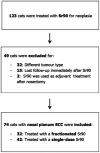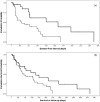Response, disease-free interval and overall survival of cats with nasal planum squamous cell carcinoma treated with a fractionated vs a single-dose protocol of strontium plesiotherapy
- PMID: 29788830
- PMCID: PMC10814631
- DOI: 10.1177/1098612X18773913
Response, disease-free interval and overall survival of cats with nasal planum squamous cell carcinoma treated with a fractionated vs a single-dose protocol of strontium plesiotherapy
Abstract
Objectives: The main aim of the study was to establish response, disease-free interval (DFI) and overall survival of cats with nasal planum squamous cell carcinoma (SCC) treated with Sr90 plesiotherapy. A secondary aim was to determine whether a fractionated protocol is more effective than a single-dose protocol in terms of response, DFI and overall survival. The third aim was to evaluate whether we can identify prognostic factors that influence overall survival.
Methods: This was a retrospective study that included cats with a diagnosis of nasal planum SCC treated with Sr90 plesiotherapy at a single institution.
Results: Seventy-four cats were included in the study. Thirty-two were treated with a fractionated protocol and 42 with a single-dose treatment. Sr90 plesiotherapy was able to induce complete response in 74% of cats with nasal planum SCC. The median DFI was 780 days (95% confidence interval [CI] 383-1177), with 17% of cats experiencing local recurrence. The overall survival for all cats was 1039 days (95% CI 55-1528). The DFI of cats treated with the fractionated Sr90 was significantly longer compared with the single-dose treatment, whereas response and overall survival were not statistically different. Other prognostic factors that influenced the overall survival were early-stage disease, absence of concurrent problems and complete response to the treatment. Acute and long-term toxicity associated with the treatment were minimal and the aesthetic outcome was pleasing in almost all cases.
Conclusions and relevance: Strontium plesiotherapy is a safe and effective treatment of nasal planum SCC in cats.
Conflict of interest statement
The authors declared no potential conflicts of interest with respect to the research, authorship, and/or publication of this article.
Figures




References
-
- Bostock DE. Neoplasms of the skin and subcutaneous tissues in dogs and cats. Br Vet J 1986; 142: 1–19. - PubMed
-
- Miller MA, Nelson SL, Turk JR, et al. . Cutaneous neoplasia in 340 cats. Vet Pathol 1991; 28: 389–395. - PubMed
-
- Dorn CR, Taylor DO, Schneider R. Sunlight exposure and risk of developing cutaneous and oral squamous cell carcinomas in white cats. J Natl Cancer Inst 1971; 46: 1073–1078. - PubMed
-
- Owen LN. TNM classification of tumours in domestic animal. Geneva: World Health Organization, 1980.
MeSH terms
Substances
LinkOut - more resources
Full Text Sources
Other Literature Sources
Medical
Research Materials
Miscellaneous

